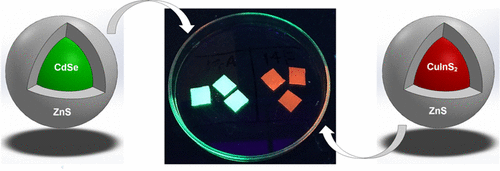当前位置:
X-MOL 学术
›
ACS Photonics
›
论文详情
Our official English website, www.x-mol.net, welcomes your
feedback! (Note: you will need to create a separate account there.)
Optical Properties and Reliability Studies of Gradient Alloyed Green Emitting (CdSe)x(ZnS)1–x and Red Emitting (CuInS2)x(ZnS)1–x Quantum Dots for White Light-Emitting Diodes
ACS Photonics ( IF 6.5 ) Pub Date : 2017-11-09 00:00:00 , DOI: 10.1021/acsphotonics.7b00980 Rachod Boonsin 1 , Anthony Barros 1 , Florian Donat 2 , Damien Boyer 1 , Geneviève Chadeyron 1 , Raphaël Schneider 2 , Philippe Boutinaud 1 , Rachid Mahiou 1
ACS Photonics ( IF 6.5 ) Pub Date : 2017-11-09 00:00:00 , DOI: 10.1021/acsphotonics.7b00980 Rachod Boonsin 1 , Anthony Barros 1 , Florian Donat 2 , Damien Boyer 1 , Geneviève Chadeyron 1 , Raphaël Schneider 2 , Philippe Boutinaud 1 , Rachid Mahiou 1
Affiliation

|
Luminescent materials become one of interesting issues for white LED-based lighting devices (WLEDs) due to their high performances for converting the monochromatic light from UV/blue LED chips into white light. Nevertheless, the availability of rare earth materials, the low color rendering index (CRI) and too-cold color temperature of the white LEDs remain some drawbacks to penetrate into the general LED lighting markets. Herein, we report the development of rare-earth-free luminescent nanocomposites combined with a UV/blue LED chip in order to provide white light. Gradient alloyed cadmium selenide/zinc sulfide (CdSe)x(ZnS)1–x and copper indium sulfide/zinc sulfide (CuInS2)x(ZnS)1–x quantum dots have been used to achieve the luminescent nanocomposite films in silicone as polymer matrix. The optical performances were investigated upon LED excitation. The photometric parameters of systems consisting of luminescent nanocomposites and LEDs including color rendering index (CRI), correlated color temperature (CCT), Commission Internationale de l’Eclairage (CIE) chromaticity coordinates, and luminous efficacy can be tuned by controlling the compositions and thickness of nanocomposite films. Furthermore, the thermal stability and the reliability of these luminescent nanocomposite films were investigated.
中文翻译:

梯度合金绿色发射(CdSe)x(ZnS)1– x和红色发射(CuInS 2)x(ZnS)1– x白色发光二极管的量子点的光学性质和可靠性研究
发光材料由于其将来自UV /蓝色LED芯片的单色光转换为白光的高性能,而成为基于白光LED的照明设备(WLED)的有趣问题之一。然而,稀土材料的可获得性,白光LED的低显色指数(CRI)和色温过冷仍然是渗透到普通LED照明市场中的一些缺点。在本文中,我们报告了结合UV /蓝色LED芯片以提供白光的无稀土发光纳米复合材料的发展。梯度合金硒化镉/硫化锌(CdSe)x(ZnS)1- x和铜铟锡/硫化锌(CuInS 2)x(ZnS)1- x量子点已被用于实现有机硅作为聚合物基体中的发光纳米复合膜。在LED激发下研究了光学性能。可以通过控制组成和厚度来调整由发光纳米复合材料和LED组成的系统的光度参数,包括显色指数(CRI),相关色温(CCT),国际照明委员会(CIE)色度坐标和发光效率。纳米复合薄膜。此外,研究了这些发光纳米复合膜的热稳定性和可靠性。
更新日期:2017-11-09
中文翻译:

梯度合金绿色发射(CdSe)x(ZnS)1– x和红色发射(CuInS 2)x(ZnS)1– x白色发光二极管的量子点的光学性质和可靠性研究
发光材料由于其将来自UV /蓝色LED芯片的单色光转换为白光的高性能,而成为基于白光LED的照明设备(WLED)的有趣问题之一。然而,稀土材料的可获得性,白光LED的低显色指数(CRI)和色温过冷仍然是渗透到普通LED照明市场中的一些缺点。在本文中,我们报告了结合UV /蓝色LED芯片以提供白光的无稀土发光纳米复合材料的发展。梯度合金硒化镉/硫化锌(CdSe)x(ZnS)1- x和铜铟锡/硫化锌(CuInS 2)x(ZnS)1- x量子点已被用于实现有机硅作为聚合物基体中的发光纳米复合膜。在LED激发下研究了光学性能。可以通过控制组成和厚度来调整由发光纳米复合材料和LED组成的系统的光度参数,包括显色指数(CRI),相关色温(CCT),国际照明委员会(CIE)色度坐标和发光效率。纳米复合薄膜。此外,研究了这些发光纳米复合膜的热稳定性和可靠性。









































 京公网安备 11010802027423号
京公网安备 11010802027423号